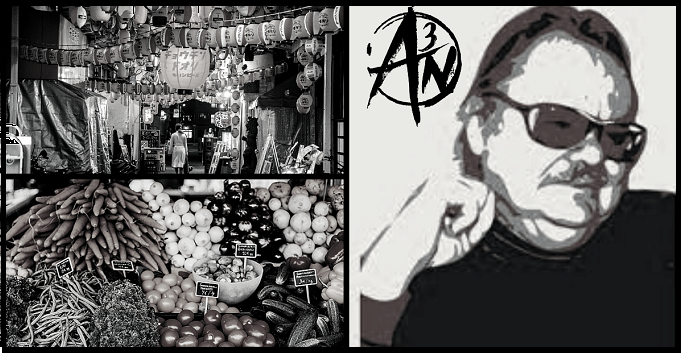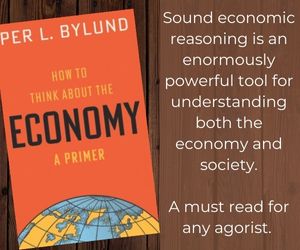
Review: An Agorist Primer by SEK3
Samuel E. Konkin III (SEK3) died alone on February 23, 2004 of natural causes at the age of 56 in his apartment in West Los Angeles, California. SEK3’s life was dedicated to one ideal: Agorism which is the movement he founded. Agorism seeks to achieve an anarchist society through a peaceful revolution called counter-economics—that is, through free-market exchanges that ignore the state and cause it to wither away from lack of acknowledgment and participation.
SEK3 reveled in the role of leading a revolution. Decades ago, I threw a party In Los Angeles at which guests were awarded mock prizes; Victor Koman—a close friend and ally of SEK3—was ‘honored’ with a plaque for the best lifetime Dudley Do-Right imitation, for example. SEK3 was literally crowned with a tinfoil garland for winning “the movement, c’est moi” award for which he was the only contender. He wore the crown all evening and out the door when he left at the first crack of dawn. He wore it well.
In those days, Agorism consisted of a handful of boisterous radicals and science-fiction fans who were concentrated in an apartment complex called AnarchoVillage in Long Beach. Today, Agorism a massive movement. It is amazing that this surge of radicalism emerged from a privately printed, small-edition booklet entitled New Libertarian Manifesto (NLM), which was written in 1980. NLM is SEK3’s best-known work by far, in part because so much of his other writing appeared as articles in the small and ephemeral periodicals he published.
But it is curious that his follow-up to NLM, An Agorist Primer: Counter-Economics, Total Freedom, and You (AAP) has received little attention. Written in 1986, the book was dedicated to three friends and “most of all…to my son, Samuel Edward Konkin IV, to whom I offer this blueprint for liberty as his legacy.” Weighing in at a little over 100 pages, the Xeroxed manuscript first circulated among those who might fund a high-quality, hardcover edition. Sufficient funds were not raised, and the project stalled. The Xerox bore the words “First Edition,” but the real first edition—the one SEK3 would have wished the world to see—was issued in December 2008 from KoPubCo. This is the publishing arm of The Triplanetary Corporation that is owned by Koman, a former resident of AnarchoVillage, a staunch Agorist, and an award-winning SF author.
In his introductory Publisher’s Note to AAP, Koman informs readers, “An effort has been made to update the book in order to keep it relevant, though none of the timeless—and timely—agorist philosophy has been altered. Such archaic terms as ‘videotapes’ and ‘cassettes’ have been replaced by ‘DVDs’ and ‘downloads’. Information about major wars since 1986 have been added, staying—we hope—in the spirit of SEK3’s other analyses. Notice has been taken of the collapse of Communism, brought about in no small part by Counter-Economics.” Given the reverence in which Koman holds SEK3’s legacy, the “spirit” of the book is sure to be intact.
AAP is an expansion of NLM that further explains the theory, principles, and practice of Agorism identifying it as the next evolutionary stage of libertarianism. It is a simple, hands-on guide to personal freedom in the here and now, which highlights the psychology of agorism. The Preface declares, “Agorism is a way of thinking about the world around you, a method of understanding why things work the way they do, how they do, and how they can be dealt with—how you can deal with them.” AAP is a political self-help book for the everyman.
SEK3 springboards into his tightly structured book with a definition of agorism. Indeed, he offers three definitions, although they can sound more like descriptions.
- “Agorism can be defined simply: it is thought and action consistent with freedom. Those who continued to seek liberty consistently and without the practical contradiction of Libertarians became agorists.”
- “When libertarian theory meets Counter-Economics, what comes out—in strict consistency, both external and internal—is Agorism. This is still another definition.”
- “Agorism is an ideology, then, but it is also a scientific and definitely materialist way of thinking. Like any scientifically based mode of thought, it will evolve as does our understanding of reality…Reality is our standard. Nature is our lawgiver.”
AAP is broken into four concepts and their applications and is eight chapters in length. The four topics are Economics, Counter-Economics, Libertarianism, and Agorism. SEK3 explains the structure; “The first six chapters of this ‘primer’ precede the actual presentation of agorism to give you, the reader, enough understanding of economics, Counter-Economics, and libertarianism to see from where the insights that produced agorism were derived.” And in case the derivation sounds dry, SEK3 assures the reader that the evolution was “not chosen arbitrarily but rather as a result of years of bitter experience and, in some cases, furious battles and acts of resistance.” Without drama but as a statement of fact, he concludes, “The ‘hard core’ agorists had to have something worth dying for, and, far more important worth living for.” This “something” is a vision of freedom that comes into focus only after Agorism is understood down to the bone.
Economics comes first because exchange is the fundamental need of society and individual well-being. SEK3 carefully distinguishes between the distorted economics advanced by politicians or academics and the real economics of everyday life. He calls the latter lower-case “e” economics, which “is the study of relations between people involving goods and services.” Lower-case economics is based on the science of human action or “praxeology,” as the Austrian economist Ludwig von Mises termed it, which proceeds from the insight that human action is purposeful. Other than reflexive behavior, like sneezing, people act in order to satisfy a want, even if the want is nothing more than the alleviation of unease. The lower-case economics can be explained through common sense language that is easy to comprehend.
Capital “E” Economics stands in stark contrast. It is phrased in arcane language and mathematical formulas so to confuse and intimidate average people. Capital “E” Economics is “an institution financed mostly by government and its tax-privileged foundations.” It reflects the needs and nature of the state, not of human nature. In making this distinction, AAP immediately separates human nature from the state and places the two of them at odds with each other on the battleground of economics.
What are the common sense terms that explain lower-case economics? SEK3 spells out the basics of Austrian economics in AAP.
Value comes first. Again, human action is voluntary and it has the goal of achieving something that the acting individual values. The value itself is subjective, which is to say that value is not intrinsic but varies from person to person. Even life has no intrinsic value to someone who wishes to commit suicide. Exchange is a form of human action by which two people achieve their separate values by trading for something they each want more than whatever it is they already have.
Marginal utility affects how a person values a thing with the benefit of consuming a good being reduced with every unit that is added to the process. Apple #1 is eaten to appease hunger and is more highly valued than apple #2 that is placed in a bowl for decoration, for example. Apple #2 is marginalized because its use-value is less than Apple #1.
Division of labor occurs when different people produce different goods or services, usually because they can do so more efficiently or with some other advantage. In a diverse society, every person can obtain a variety of goods by trading what he produces with others who specialize in what they produce. An apple grower trades fruit for a widget, and both parties benefit from the efficiency of the marketplace.
Complex exchanges that involve more than straight barter tend to result in money. Person A does not wish to trade his apples for a widget from Person B but he will accept a highly exchangeable good for the fruit because he can easily trade this good for something he does want from Person C. The highly exchangeable good becomes a medium of exchange and, if it is widely accepted through society, it becomes a popular form of money. Gold is a common example.
When money evolves naturally, it reflects people’s preferences and becomes the great facilitator of complex exchange. When it is produced by a state that mandates its use and restricts competition, however, money reflects the state’s preferences and diverts wealth away from the productive sector. SEK3 uses Austrian economic theory to contrast the two forms of money and explain “why fiat money exists at all and what it has to do with inflation.” Fiat money is how the state monopolizes the essence of economic exchange: value. Once the state is in control of exchanges, it can dilute this value through inflation, which is a stealthy form of theft.
(Throughout this section, SEK3 credits economists like Carl Menger with originating key concepts and concludes, “If this area of study appeals to you, by all means go to the source: Human Action by Ludwig Von Mises.”)
Chapter Two, Applied Economics, opens with the word most associated with SEK3: “Agorism.” “Agorism is more than economics…It upholds the free market.” To understand ‘why’, “one first needs to know what the free market is, and what its alternatives are.” Freedom is the absence of coercion and it is a prerequisite of value. By contrast, violence creates a lack of value to the coerced person who relinquishes a good rather than exchanging it. “The coercer gains without producing anything of value and the victim always loses.” Over time, this dynamic destroys all value, which is the motive behind human action itself. Individuals and society stagnate.
Or rather, they would do so if human beings were not endlessly resourceful. In the presence of coercion, they find solutions and work-arounds. If only private criminals exist, then people act to control this temporary disruption and something close to a pure free market can function. But even ”if coercion becomes regular and predictable”—that is, even if a state emerges—”innovative people find ways around it and soon enough join forces to evade the coercive regulations, frustrating and/or starving the coercer.” Agorism arises spontaneously as a path to freedom and prosperity. No overall coordination is necessary because “a completely free market is a highly decentralized order. Each ‘cog’ in the great machine keeps itself well-oiled and seeks to mesh itself with the other cogs in ever-better fits.” Each person independently acts in his own self-interest.
The free market’s decentralization becomes a huge advantage because it is flexible, quick to respond, and impossible to suppress in total. The agorist order is spontaneous and peaceful, with everyone pursuing his own self-interest. Since society is voluntary, “competition is always good in the sense that it maximizes value exchanges.” Both parties benefit, and the more parties participate, the greater the benefit becomes. Meanwhile, the centralized state is trapped in an attempt to impose the fallacy of a planned economy—“the error of assuming that order is imposed. It is not. Scientists are aware that order is something you look for in nature—it’s already there.”
From here, SEK3 moves on to make a controversial distinction between “capitalism” and the “free market. Capitalism means the ideology (ism) of capital or capitalists.” SEK3 notes that “the term capitalism” was once used as “a pejorative” because “capitalists were trying to use coercion—the State—to restrict the market.” But a more standard definition of capitalism is “an economic system based on the private ownership of the means of production and their operation for profit.” It includes the concepts of private property, wage labor, capital investment, competitive markets, and prices; it does not involve coercion to restrict the market. Those who emphasize the non-state or anti-state aspects of capitalism often refer to the system as “laissez-faire capitalism.” What SEK3 seems to be condemning is crony capitalism—a system characterized by a mutually advantageous partnership between business and government at the expense of the free market.
Nevertheless, SEK3’s interpretation of capitalism takes him where he wants to go. “Capitalism, then, does not describe a free market but a form of statism.” As to the definition of the free market, “there are three productive functions in the marketplace: Labor, capital, and entrepreneurship.” In a primitive society, capital consists of tools and other materials that sustain a person until goods like a harvest can be exchanged. Labor is the work invested. Entrepreneurship is direction in which capital and labor is taken. Markets may be more or less complex, but these three characteristics operate in much the same manner.
Statism disrupts the free market through regulation that does more than merely destroy the dynamics of exchange. It also destroys people’s ability to acquire the tools with which to protect themselves from the state. No tool is more important than information and sound judgment. Nothing protects “innocent people more than a thorough education and a vigorous pursuit of fraud” but “the regulation of advertising and experimentation destroys [the] information transfer and regulation of quality” that the free market otherwise provides. By controlling the flow of information—that is, by censorship and propaganda—the state denies people access to a thorough education and the ability to pursue fraud. When the state certifies “incompetent ‘professionals’” and prohibits free-market competitors, for example, fraud is protected and almost assured.
Then of course, theft through taxation causes disruption as well. When the suppression of knowledge, the fraud and the theft become too burdensome or enraging, people turn to counter-economics. People embrace the black market. This is the topic of Chapter Three.
The counter-economy is already here and it is vast. Tax evasion. The drug trade. Smuggling by tourists or pros. Sex work. Traffic violations. Lying on forms. Trespassing to take a short cut. Littering. Under-the-table wages. Building code violations. Off-the-book rentals. Lying to airport officials and more. In his book Three Felonies A Day: How the Feds Target the Innocent, civil libertarian attorney Harvey A. Silverglate chronicles how ‘law-abiding people’ unknowingly break the law on a daily basis simply because thousands of innocuous behaviors are prohibited. Silverglate wrote, “Perhaps the most chilling quote of the Soviet era came from Lavrentiy Beria, Stalin’s head of the secret police, who bragged, ‘Show me the man, and I will find you the crime’.” SEK3 would say, “Show me the non-violent crime, and I will find you a free man.”
But it is always best for the non-violent crime to remain unseen. Freedom of information is once more placed at the core of successful counter-economics. SEK3 asks, “if you can advertise your products, reach your consumers and accept payment (a form of information), all outside the detection capabilities of the State, what enforcement of control would be left?” None or, at least, none that is effective. Even in 1986, SEK3 exuded optimism about the incredible freedom of information promised by technologies such as encryption.
Chapter Four deals with what SEK3 calls “the basic law” of Applied Counter-Economics—namely, trading risk for profit. The state is the overwhelming risk to an agorist. True to praxeology, therefore, the agorist acts to reduce his unease by reducing the risk of the state. Ironically, the successful agorist increases his advantage over competitors by taking the risk of confronting the state in the first place. By not complying with the law, for example, he lowers his costs (e.g. taxes) and expands the range of possible actions. Ignoring or breaking the law becomes a market advantage.
Counter-economic profit comes down to identifying and assessing the risks of an unsanctioned trade. SEK3 observes, “the government itself gathers statistics concerning apprehension of ‘criminals’. And it publishes them. The police agencies brag about how few cases are solved and how fast the ‘crime rate’ is growing to justify ever-bigger budgets…The highest apprehension rate for the most foul crimes seldom hits 20%, an indication of government effectiveness in maintaining public order.” Moreover, since the vast majority of crimes go unreported and undetected, the state’s low rates of apprehension are unrealistically high when compared to the total crimes committed. The odds overwhelmingly favor the agorist.
SEK3 provides a blueprint on how to estimate the risk versus the profit of a counter-economic trade. Imagine buying a good for $10,000 which is sold for $20,000, with a overhead of $5,000. The net return is $5,000 on an investment of $15,000, or a 33% profit. But the profit is worthwhile only if the risk is low enough—a matter that can also be calculated. Assume an apprehension rate of 20% for the risky trade in question, which brings a maximum fine of $50,000 or six months imprisonment. This means the downside-monetary risk is 20% of $50,000 or $10,000. In this example, SEK3 concludes, “it would not be worth it: to gain $5,000 but risk losing $10,000.” If the apprehension rate is 10% and the fine is $25,000, however, then the risk would be $2,500 for a profit of $5000. “You could get caught one time in ten, pay off your fines, and still come out way ahead.”
Realistically, the estimate would also “include the price of a lawyer to beat your charges and [beat] the probability of being convicted after apprehension.” Assume that the cost of a lawyer on retainer raises the overhead by $1000 per transaction. This reduces the profit to $4000, “but the conviction rate (with plea bargaining and court delays) is only 20%. (Again, that is high in many jurisdictions; many cases are dropped long before they come to trial.) Now your risk, using our first figures, is 20% of 20% of $50,000, or $2000. With a payoff of $4000, a loss of $2000 would deter few entrepreneurs.”
The formula with which to assess a black-market business prospect: “Counter-Economic Payoff = profit minus loss = (Promised price) minus (cost minus [Sic, should be plus?] overhead) minus ((Penalty or Fine) x (probability of arrest) x (probability of conviction)). If positive, go. If negative, don’t go.”
The foregoing calculations may sound cold and purely mathematical, but SEK3 does not dismiss what he calls the “subjective values” of the agorist. Due to a pathological fear of law enforcement, he may conclude that any risk is too emotionally grueling for him to take. Or the agorist may revel in flaunting the state and do so whether or not the risks are high and the profit is modest. (More on agorist psychology later.) SEK3’s formula for risk assessment is provided with no judgment passed on whether a person chooses to use it or not.
Certainly, risk can and should be lowered to prevent dangers such as accidental discovery. This risk aversion involves being discreet with anyone other than trusted friends, researching the risk of a specific activity, learning to spot state agents, never leaving an accessible paper trail, increasing the payoff, and other counter-economic protections acquired through experience and mistakes. The tactics will differ from agorist to agorist because only the person acting knows his own profession and circumstances, including which regulations, locations, suppliers, and customers to avoid. One of the most effective protections is to be part of an agorist community that provides economic and psychological support. “Division of labor, subjective value, and human individuality all contribute to making your case (and everyone else’s) unique.” The agora pools these advantages and strengthens every member.
Chapter Five, “Libertarianism” may elicit disagreement from readers. SEK3 assumes that ”where Counter-Economics is application without theory, Libertarianism is theory without application.” A free society is the goal of both, he acknowledges, with a free society being “one in which Man is constrained only by unthinking Nature.” The main question becomes, “How do we achieve a free society?”
Here, SEK3’s cynicism about libertarianism is evident. “Parlor Pinks” is what George Orwell called socialists who refused to dirty themselves by street fighting for their beliefs. “Library Libs” is what SEK3 calls their libertarian counterparts. SEK3 does not dismiss theorists—far from it. He gives them great credit when credit is due. ”Libertarian theory provided the crucial insight as to why Counter-Economics was morally correct as well as (obviously) practical and very profitable,” he states. “The crucial issue was that of the State, its nature, and its evolution. The easiest paradigm for the origin of the State was offered by Franz Oppenheimer, a German sociologist, and adapted into American libertarianism in Albert J. Nock’s 1935 book, Our Enemy, The State. All historical examples fit this simple paradigm…”
Libertarian theory laid the groundwork for Agorism. Specifically, it explicitly revealed the antagonism between state and society regarding how each acquired wealth; this was the first insight of Agorism. In his pivotal book The State, Oppenheimer labeled the antagonism, “I propose in the following discussion to call one’s own labor and the equivalent exchange of one’s own labor for the labor of others, the ‘economic means’ for the satisfaction of needs, while the unrequited appropriation of the labor of others will be called the ‘political means’.” The economic means is voluntary and productive; the political means is coercive and parasitic. In the wake of this insight, “agorists looked for the proper means to achieve a free society or at least a fully libertarian society. They sought market means only. The author of this book and his companions found the Counter- Economy ‘staring them in the face’ as soon as they thought of looking.”
They did not look into the libertarianism surrounding them however, because of reservations that are briefly expressed in Chapter Six, “Applied Libertarianism.” The section entitled “The Libertarian Failure” identifies what SEK3 clearly considers to be a flaw in the movement: libertarians are a pluralistic group. By this, he means that “different interpretations of Liberty and how to achieve it” are everywhere; the diversity is celebrated as an advantage by those who believe the “anything that’s peaceful” principle allows the individual to decide the specifics of his life.
Unfortunately, electoral politics entered the strategic mix and voting—placing people in power over unconsenting others—began to dominate as the strategy for freedom. Alleged anarchists who accused the state of being irredeemably coercive lined up to run for office and be included in its ranks. At this point, “the burning issue shifted from ‘which new libertarian theory works and which does not?’ to ‘which ‘Libertarian’ candidate can get elected?’ To many, Libertarianism was a fine theory which had no obvious practice.” And, so, in SEK3’s opinion, electoral politics filled the strategic void because libertarianism had no realistic way to spread its principles into the street.
Chapter Seven presents the next evolutionary step of libertarianism: Agorism, which translates its principles into reality through Counter-Economics. SEK3 returns to basic questions. ”To understand agorism fully and to compare it to competing ways of thinking, one needs to know two things about it: its goal and its path to that goal. This knowledge is critical to evaluating all ideologies.” Framework is provided through five axioms or established truths.
- The closest approach to a free society is an uncorrupted agora or open marketplace. The Agora is not perfect because every society contains some private crime that violates freedom.
- The agora self-corrects for small perturbations of corruption. In other words, the free market deals with criminals.
- The moral system of agora is compatible with pure libertarianism because both are based on peaceful, voluntary interaction.
- “Agora in part is agora in whole; to a workable approximation, the corruption of an agora raises protection costs and risks.” The means and the ends are one.
- Agorist theory is an open system, which means reflection and experience may add more axioms.
Little detail is available on how these axioms can be translated into reality. Justice and National Defence are the two areas sketched out in AAP, probably because these issues are viewed as Achilles Heels for anarchism and Agorism.
Practical justice, as opposed to the principle of justice, is “a business…an economic service.” SEK3 expands with an example. “Your completely tricked-out media center is stolen from your home.” You notify the Laissez Faire Insurance and Protection Company (LFI&PC). “As fast as modern technology permits, you receive” equipment “to replace the original, with downloads of any programs you missed in the interim. You have achieved full restoration…to the condition it would have been had there been no act of aggression. Surely that is the goal of Justice.” Then, LFI&PC pursues restitution from the thief.
SEK3 uses LFI&PC as the prototype of a justice service to which subscribers delegate their right of defensive force. The subscribers can purchase justice, including protection, in at least three ways. The insurance company allows members to pool their assets and distribute the risk of a crime that might occur to one of them. Protection in the form of locks and other security measures defends property and lowers the price of LFI&PC premiums. The aggressor, when apprehended by LFI&PC, pays the cost of replacing the property in question, interest on this money, and any expenses related to processing the case.
AAP devotes a lamentable amount of space to contrasting the efficiency and morality of free-market justice with that of the state. It is lamentable because the points seem obvious and the space could have been used to expand upon what justice might look like under Agorism.
The same is true of the ensuing section on national defense which attacks the state more than it builds an alternative. “Full Agorism obviously needs no national defense,” the section opens. After all, there would be no nations. Partial Agorism is another story, however, as hostile nations or rogue defense agencies could aggress against agoras. The solutions advanced by AAP are superficial and unsatisfying, which is understandable in a short book intended as an overview. It would have been valuable, however, for SEK3 to refer readers to more substantial work on free-market ‘national’ defense by authors like Gustav de Molinari as he recommended Mises’s work in the Economics chapter.
Instead, SEK3 focuses on a comparatively lengthy critique of American wars from the War of 1812 through to the Iraq War II; Koman added the latter wars. Agorist strategies are discussed in passing, such as boycotting coercive attackers, the role of syndicated protection agencies, and guerrilla units. But Gene Sharp’s three-volume The Politics of Nonviolent Action would have been an excellent work to mention in this regard.
Returning to the overall picture, SEK3 concludes AAP by addressing “the last step in Agorism,” which is getting there from here. ”Unlike libertarianism, agorism offers both goal and path as an internally consistent package deal.” The ends and the means of Agorism are in harmony; or, as Gandhi once stated, “Means and end are convertible terms in my philosophy of life.” As for the specifics of how to get to Agorism, SEK3 advises, “The short answer is given in Axiom Four”: “Agora in part is agora in whole.” A longer answer is by “applying Counter-Economics to all your actions and linking preferentially with others who do so” in order to create “an ever-bigger agora.” Be a role model who embodies living agorism.
Chapter Eight is “Applied Agorism.” Interestingly, much of it dwells upon psychological Agorism in which activism is rooted. The road to Agorism begins with shedding what Ayn Rand called “the sanction of the victim.” This is the misguided willingness of good people to suffer at the hands of evil ones by accepting the role of sacrificial victim for the “sin” of creating values or being productive. They allow themselves to be used and exploited out of guilt from a belief in self-sacrifice, duty, or some other psychological confusion. Rand’s touchstone novel Atlas Shrugged can be seen as an exploration of what happens to society when productive people revoke this sanction. Deeply influenced by Rand in his youth, SEK3 had an answer; Agorism happens.
Demystification of the state is next. Mystification is the process by which the commonplace is elevated to the level of the divine by those who have a vested interest in its unassailability. The state is a perfect example. The state is nothing more than a group of individuals who organize for the purpose of extracting wealth and exerting power over others in a given jurisdiction.
Ordinarily, people object to thieves and thugs rather than deify them. People do not resist the state, however, because it is wrapped in a mystique of legitimacy that is established by dynamics such as elections. When people refuse to swallow the mystification, however, “the Counter-Economy grows both vertically and horizontally. Horizontally, it involves more and more people who turn more and more of their activities toward the counter-economic; vertically, it means new structures (businesses and services) grow specifically to serve the Counter-Economy…Eventually, the ‘underground’ breaks into the overground where most people are agorists, few are statists, and the nearest State enforcement cannot effectively crush them.”
The state will eventually use force against the agoras but its attempt to coerce “a rebellious majority” is doomed. After all, “it cannot even stop an enterprising minority of black marketeers and other Counter-Economists.” The true battlefield on which the State must prevail is in the mind of the individual because a person who breaks the hold of state power is a free man. To encourage the severing of state bonds, an agorist psychology is required. Perhaps it can promoted by consciousness-raising groups of kindred spirits who dig through each other’s contradictions to flush the state out their systems, like an addiction. “Every law that you obey must be reexamined with the thought, how does it protect life and property?,” SEK3 insists. “If, as almost every law in our system does, it actually constricts the market or steals outright, it should not be obeyed save when force is reported nearby and menacing you directly.” Agorism must be internalized and become second nature.
“Remember, an agorist is one who lives counter-economically without guilt for his or her heroic, day-to-day actions, with the old libertarian morality of never violating another’s person or property. There is no ‘membership card’ to fool you;
an agorist is one who lives agorism. Accept no counterfeits…As Yoda said so succinctly, ‘Do. Or do not. There is no try’.
“That’s Agorism.”








2 comments
DANIEL EMERSON TWEDT
June 27, 2020Wendy, you’ve again managed an excellent capture of both a unique historical moment and a seminal text from an equally unique and wonderful person. I intend to send it on to a wider audience such as I can. Your talents are, as always, very much appreciated.
Wendy McElroy
June 29, 2020Thank you, Danny. I am planning to edit the essays on SEK3 and issue them as a book. If you have any memories or anecdotes that you would like to include, I would be most pleased to receive them. The Agorist Nexis site has inspired me. Stay safe and in good health.